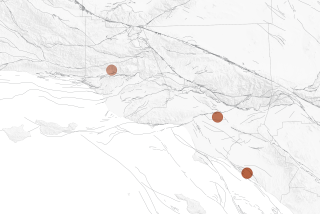Predicting Earthquakes Is Impossible
- Share via
The Northridge earthquake--magnitude 6.8--caused 60 deaths and billions of dollars in property damage. Immediately after the earthquake, the rumor began to spread that seismologists at the California Institute of Technology had predicted an even larger earthquake. Caltech’s response was that “Caltech cannot release predictions since it is impossible to predict earthquakes.”
The vast majority of the world’s seismologists think that earthquakes cannot be reliably and accurately predicted.
Despite great progress in seismological research, no physical law or mathematical formula now exists for reliably predicting the time, place and size of an earthquake.
In order to predict earthquakes, one would have to find a precursory phenomenon that always occurs before a large earthquake but never occurs otherwise. Seismologists throughout the world have searched for such a precursor for more than 100 years but their attempts have failed.
Small earthquakes occur continually but relieve only a negligible portion of the accumulated strain energy. Occasionally one of these small earthquakes will trigger a chain reaction--an avalanche of small earthquakes occurring within a few seconds--that we perceive as a single large earthquake. But since large earthquakes and small earthquakes both start in the same way--as a small earthquake--there are no scientific grounds for believing that large earthquakes are preceded by unique precursory phenomena that would allow them to be predicted.
After a large earthquake, there frequently are reports of precursors, such as changes in the water level of wells or anomalous animal behavior. Even if such reports were accurate, these phenomena have no established link with the onset of earthquakes. Sometimes there are more credible observations, such as reports of foreshocks. Unfortunately, foreshocks are just like any other small earthquake. They can only be identified as foreshocks after the main shock has occurred.
The difficulty of predicting earthquakes is further underscored by the Parkfield Earthquake Prediction Experiment on the San Andreas Fault. Several predictions have been issued, but all have been false alarms. Meanwhile, large earthquakes have occurred in Landers and Northridge.
Predicting earthquakes is by no means the only way that earthquake damage can be minimized. Seismologists in the United States and Japan have been stepping up efforts to speed the dissemination of information on earthquake location and magnitude, so that authorities can begin to mobilize and dispatch disaster relief forces within minutes of a damaging earthquake. Seismologists also are improving the speed and accuracy of warning of tsunamis--seismic sea waves--after earthquakes occur.
Seismologists can also provide statistical estimates of the long-term seismic hazard. Such estimates, as well as statistical estimates of the expected strong ground motion, are important data for use by engineers in designing earthquake-resistant structures.
Prediction claims attract intense and unwarrantedly optimistic coverage by the media. Charles F. Richter, developer of the earthquake magnitude scale, commented in 1977, “Since my first attachment to seismology, I have had a horror of predictions and of predictors. Journalists and the general public rush to any suggestion of earthquake prediction like hogs toward a full trough. [Prediction] provides a happy hunting ground for amateurs, cranks and outright publicity-seeking fakers.”
Twenty years later, Richter’s words still apply. The media continue to publish favorable reports on prediction claims that are not generally accepted by the scientific community.
The public, media and government authorities must be clearly informed that earthquake prediction in its popularly understood sense is impossible at present, that all efforts to date have been failures and that there are no reasonable prospects in the near future.
More to Read
Sign up for Essential California
The most important California stories and recommendations in your inbox every morning.
You may occasionally receive promotional content from the Los Angeles Times.










